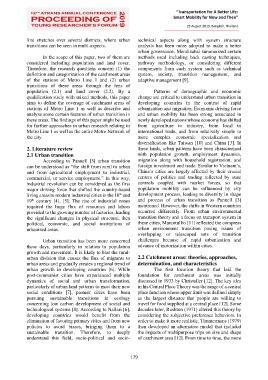Page 204 - Proceeding of Atrans Young Researcher's Forum 2019_Neat
P. 204
“Transportation for A Better Life:
Smart Mobility for Now and Then”
23 August 2019, Bangkok, Thailand
line stretches over several districts, where urban technical aspects along with system structure
transitions can be seen in multi-aspects. analysis has been more adopted to make a better
urban governance. Mendizabal summarized certain
In the scope of this paper, two of them are methods used including back casting techniques,
considered including population and land cover. pathway methodology, or considering different
Therefore, the research questions concern (1) the components from each system such as technical
definition and categorization of the catchment areas system, society, transition management, and
of the stations of Metro Line 1 and (2) urban adaptive management [9].
transitions of these areas through the lens of
population (2.1) and land cover (2.2). By a Patterns of demographic and economic
qualification study with mixed methods, this paper change are critical to understand urban transition in
aims to define the coverage of catchment areas of developing countries in the context of rapid
stations of Metro Line 1 as well as describe and urbanization and migration. Economic driving force
analyze some certain features of urban transition in and urban mobility has been strong associated in
these areas. The findings of this paper might be used newly developed nations whose economy has shifted
for further approaches in urban research relating to from agriculture to industry, from local to
Metro Line 1 as well as the entire Metro Network of international trade, and from relatively simple to
the city. more complex economic specialization and
diversification like Taiwan [10] and China [3]. In
2. Literature review these lands, urban patterns have been characterized
2.1 Urban transition with population growth, employment dynamics,
According to Pannell [3] urban transition migration along with household registration, and
can be understood as “the shift from rural to urban foreign investment and trade. Similar to Vietnam’s,
and from agricultural employment to industrial, China’s cities are largely affected by their crucial
commercial, or service employment.” In this way, centers of politics and trading reflected by state
industrial revolution can be considered as the first controls coupled with market forces, so that
major driving force that shifted the country-based population mobility can be influenced by city
living areas to modern industrial cities in the 18 and development process, leading to diversity in shape
th
th
19 century [4], [5]. The rise of industrial zones and process of urban transition as Pannell [3]
required the huge flux of resources and labors mentioned. However, the shifts in Western countries
provided to the growing number of factories, leading occurred differently. From urban environmental
the significant changes in physical structure, then transition theory and a focus on transport system in
political, economic, and social institutions of these cities, Marcotullio [11] reflected the compress
urbanized areas. urban environment transition posing issues of
overlapping or telescoped sets of transition
Urban transition has been more concerned challenges because of rapid urbanization and
these days, particularly in relation to population advance of motorization within cities.
growth and movement. It is likely to blur the rural-
urban division that causes the flux of migrants to 2.2 Catchment areas: theories, approaches,
urban areas and gradually creates a regional trend of determination, and characteristics
urban growth in developing countries [6]. While The first location theory that laid the
post-communist cities have experienced multiple foundation for catchment areas was initially
dynamics of social and urban transformation, discussed in 1933 by Christaller [12]. The key idea
particularly of urban land patterns to meet their new in his Central Place Theory was the range of a central
social conditions [7], pioneer cities have been place function whose upper limit was defined simply
pursuing sustainable transitions in ecology as the largest distance that people are willing to
concerning low carbon development of social and travel for food supplied at a central place [12]. Some
technological systems [8]. According to Nallari [6], decades later, Rushton (1971) altered this theory by
developing countries would benefit from the considering the subjective preference behaviors. In
elimination of favoring primary cities and from new order to make it more realistic, Timmermans (1979)
policies to avoid biases, bringing them to a then developed an alternative model that included
sustainable transition. Therefore, to deeply the impacts of multipurpose trips on size and shape
understand this field, socio-political and socio- of catchment area [12]. From time to time, the more
179

